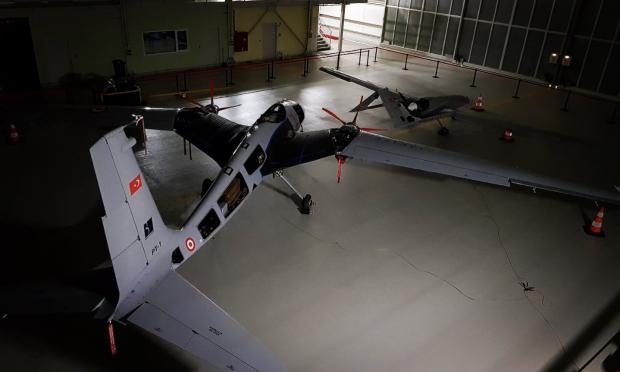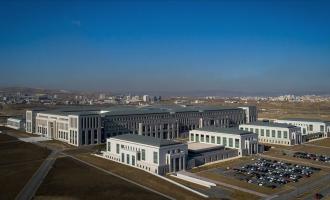It is a fact that Turkey has made rapid progress in the field of DRONEs, such as UAVs, UCAVs, kamikaze drones, unmanned helicopters, maritime USVs and land-based UGVs, in recent years.
Turkey is about to export its drones to 40 countries as of 2014, with Bayraktar exporting its TB-2, AKINCI, ANKA and AKSUNGUR UCAVs.
Significant work is also being carried out on land-based unmanned vehicles and unmanned maritime vehicles.
The first generation systems developed have started to enter the Turkish Armed Forces' inventory for testing. In addition, the first unmanned submarine is expected to be presented in 2024.
Turkish media, asks the following question, "while efforts in the field of unmanned systems continue, can we now see a new command called "Unmanned Systems Command" in the Turkish Armed Forces?
Attempting to answer he states:
The "Space Command", whose organizational work continues within the Turkish Air Force, also gives an indication of the Turkish Armed Forces' perspective in this direction.
Hudson Institute Senior Analyst and Edam Defense Program Director, Dr. Can Kasapoğlu, made assessments on "Unmanned Systems Command" , noting:
"The Age of Robotic Warfare Systems"
"Robotic warfare systems are becoming increasingly dominant in the warfare and operational environment of the 21st century.
In this respect, we have two battlefields that we can literally call its fields of application.
One is the Russia-Ukraine war, which is in its second year. The other is the current security situation in the Middle East, which is evolving rapidly with the possibility of regional conflict.
The trends I mentioned are not limited to the UAV/UCAV segment. For example, we see that the Ukrainian military intelligence service (GUR) is systematically using unmanned surface naval warfare platforms against the Russian Black Sea fleet. This trend has also extended to underwater robotic warfare capability with the Marichka.
Of course, the robotic warfare trend we are talking about is not limited to strategic systems alone. Ukraine's Ministry of Digital Transformation has already taken over the management of the country's drone program.
Information received from the field indicates that FPV kamikaze and mini drone systems with rotary wing are currently in use in Ukraine. In fact, according to various official statements, Ukraine's losses have reached 10,000 platforms per month.
Available data show that on a typical day, the Ukrainian Armed Forces use 500 unmanned systems of various categories in the air.
Of course, it should also be underlined that the Iranian-designed Shahed-131 and Shahed-136 kamikaze drones caused great damage to the Ukrainian infrastructure.
If we go back to the Middle East, we have seen that drones have an important place in the Hamas/Islamic Jihad/Israel conflict. In summary, as we have mentioned, the warfare and operational environment of the 21st century is gradually moving into a phase where unmanned systems are increasingly dominant.
Turkey's current inventory of unmanned systems
Turkey, together with the US, is the two most advanced countries in the widespread use of unmanned systems in the NATO alliance. Breakthroughs in the field have resulted in a significant increase in the combat capability of the Turkish Armed Forces.
Turkey's experience was extended to the Azerbaijani Armed Forces and there was a serious expansion of exports in the sector.
Currently, the roadmap manifested mainly with UAV/SIHA in the physical warfare dimensions in Turkey is later evolving into SİDA and now UAV capabilities.
Existing trends
However, although it is not possible to highlight everything in one interview, some trends stand out.
The first is the evolution of Turkey's stockpile of unmanned platforms into strategic weapon system capabilities.
In this context, the AKINCI missile tests and the cruise missile tests (see Çakır) are very critical.
The second important trend is that Turkish unmanned platforms have acquired very interesting payload configurations.
The Aksungur anti-submarine warfare capability is a very important example.
The third trend is that Turkey's unmanned platforms are developing a capability that we can call "cross-sectoral" in Anglo-American parlance.
The ability of the Aselsan-built Albatros SİDA to successfully engage in a swarm attack on a platform where the Bayraktar TB2 is detecting targets is an extremely critical capability for the sector.
On the other hand, the gradual development of machine learning and convolutional algorithms such as STM (Kargu, Alpagu) and Kemankeş products is also an important trend.
The fact that the Kemankeş is equipped with electro-optical sensor systems in addition to the head is a strategic example of evolution in the field. I note that the future will be mainly in the field of mobile munitions / kamikaze drones, especially in the field of robotic warfare - UCAV.
Finally, for effective use of unmanned platforms, it is also important to develop not only systems but also platforms subject to analysis into combat/command and control networks that can communicate with each other and perform joint operations.
"Turkey's need for an Unmanned Systems Command"
In the last article I wrote for Anadolu Agency, I emphasized that Turkey needs to have a joint robot warfare specialization unit.
There may be different mental exercises for this particular topic. In fact, we know that there are some discussions within the Unmanned and Intelligent Systems Command.
The reasons for this
The first is that military technology only makes sense in relation to operational plan and doctrine.
Therefore, in addition to the development of systems, it is also necessary to conduct a concept study in order to produce an unmanned operational plan that will dominate the system that can be used on the battlefield of the future.
The second important point is that various Turkish solutions (such as MARLIN) have been demonstrated in NATO exercises. We know that some Turkish SIDAs, such as the MİR, have been designed to NATO standards and can perform critical missions such as anti-submarine warfare.
On the other hand, it would be more advantageous and more effective to perform this capability under an independent command that can contribute to NATO exercises.
The third important issue is that such a command would take responsibility for monitoring conflicts related to robotic warfare trends in the world and preparing lesson learned records.
To sum up, underlining the common character, I believe that Turkey definitely needs such a command."
Roles-missions of the new Administration
The role of the new Turkish Inter-Divisional Command with manned systems is estimated to be very important, operating either in conjunction with the other branches of the Turkish Armed Forces (TAF), or in isolation, or as an important reserve, constituting a critical multiplier during ongoing military operations.
As an indication, we mention two of the many missions that the above Command could undertake.
For example, it could massively use its airborne unmanned systems- assets in combination with the Turkish air force or even individually ,to strike strategic targets on our Aegean islands, achieving the disorganization of the defending forces in them, while causing a significant reduction in our stock of missile-air defense systems.
It could also secure Turkish Special Forces air cover (AS/C) on our islands, making massive use of kamikaze drones that would operate above our counter-attack force routes as "air cut-offs", striking friendly counter-attack forces.
In conclusion, we point out that the above should ring a bell to our Armed Forces to take appropriate action, with our proposed establishment of a Trans-Branch Anti-Drone Command in the General Staff with similar missions.





